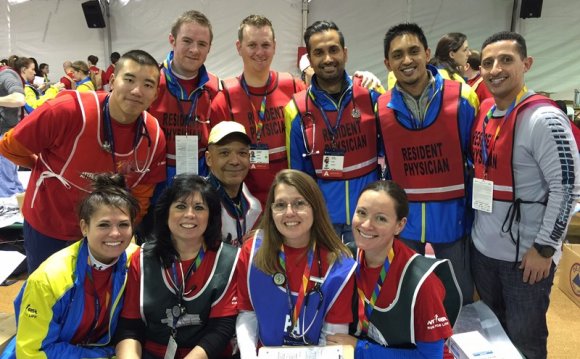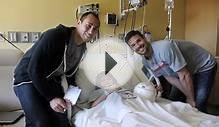
 On a recent Friday night, Sonia Agate, 46, vacantly flipped through the pages of her book in Harlem Hospital’s emergency room. She was waiting to see her partner, Suthell, who was suffering from a severe case of allergies. Agate was one of a dozen and a half others passing the time — some staring blankly at the tiled floor, others chatting idly or snoozing — until they’d be allowed to see their sick or injured loved ones.
On a recent Friday night, Sonia Agate, 46, vacantly flipped through the pages of her book in Harlem Hospital’s emergency room. She was waiting to see her partner, Suthell, who was suffering from a severe case of allergies. Agate was one of a dozen and a half others passing the time — some staring blankly at the tiled floor, others chatting idly or snoozing — until they’d be allowed to see their sick or injured loved ones.
Despite a mountain of research showing that family presence in the hospital leads to better health outcomes, New York City’s public hospitals lag in adopting more flexible visiting policies. At Harlem Hospital, visitors in the emergency department can sit with patients for just 10 minutes in an hour. Agate anticipated she would stay at the hospital for another five hours, only being able to see her partner for less than one-fifth of that time.
“There’s no leeway. They come back there and get you, ” said Agate, speaking from experience. She said she has sat in that same room waiting to see loved ones six times this year, wasting countless hours in a mix of anxiety and boredom. And while some city hospitals give nurses discretion over the length of visits to patients, Agate said that Harlem Hospital doesn’t bend.
“They say 10 minutes and they mean 10 minutes, ” she said. “They don’t play.”
An August report by an advocacy group, New Yorkers for Patient and Family Empowerment, found that New York state and city hospitals have largely resisted expanding visiting hours despite increasing pressure from health care quality groups and government agencies. New research on the subject of visitation in hospitals suggests that the traditional medical wisdom — that unbounded family presence can be harmful to patient care — is wrong.
The city’s Health and Hospitals Corporation, which runs 11 of the city’s hospitals, has particularly strict visiting rules. The report found that only one in the network offers at least 10 hours daily of visitation on average across departments. And Harlem Hospital is one of seven to limit emergency department or intensive care unit visits to between 10 and 15 minutes an hour.
The city hospital agency has been assessing its visiting hours and making some improvements. “HHC has been actively expanding it visitation policies as part of a comprehensive ongoing review effort, and in 2012 alone visiting hours were increased at seven separate HHC hospitals and several nursing and long-term care centers, ” said a spokesperson for the agency. Those facilities, the spokesman said, were Coney Island, Harlem, Kings County, Metropolitan, North Central Bronx, Lincoln and Woodhull hospitals.
“However, the process of setting visitation policy is a complicated one and requires balancing several factors, including evidence of how visitor policies affect patient care, the constraints brought on by staffing and security requirements, operational capabilities, and the need for patients to be able to rest and have quiet within their rooms.”
Yet research on the topic has found that family presence in the emergency room and hospital wide actually leads to better patient outcomes and higher patient satisfaction — both key metrics in new federal reforms to financially reward or penalize hospitals based on care. The Joint Commission, the agency charged with accrediting hospitals across the state including HHC facilities, updated its rules last June, adding a provision requiring hospitals to allow friends, families and other supporters to visit patients “during the course of stay.”
Meanwhile, a growing number of advocates, academics and health-care worker associations maintain that better access to loved ones actually leads to healthier patients.
“Patients need their family, and whenever possible we advocate keeping loved ones with the patient, ” said Gail Lenehan, President of the Emergency Nurses Association — a 40, 000-strong group of nurses who work in emergency rooms across the country. In 2009, the association supporting open visitation for families, friends and other support persons even during the most intensive procedures. Three years later, Lenehan said the group is still a “strong advocate.”
“After 30 years of experience in the emergency room, what you learn is what bothers people the most, what’s the most unbearable, is not knowing, ” she said.
A few hospitals around New York State and City offer around-the-clock visiting hours, and administrators there say they have been pleased with the results. The North Shore–Long Island Jewish health system, which runs 16 hospitals in the state — including Lenox Hill Hospital, Long Island Jewish Medical Center and Staten Island University Hospital in the city — recently rolled out a 24-hour visiting policy across all of its hospitals and departments.
Elaine Smith, vice-president of nursing education for the system and one of the lead administrators behind its visitation reform task force, said administrators faced some resistance among doctors and nurses after the change was announced, but that hospitals and their staffs are now on board.
RELATED VIDEO




 Touro University College of Medicine was a proposed medical school to be based out of Hackensack, New Jersey. Its hospital affiliate was to be Hackensack University Medical Center (HUMC). The medical school disbanded in December 2009.
Touro University College of Medicine was a proposed medical school to be based out of Hackensack, New Jersey. Its hospital affiliate was to be Hackensack University Medical Center (HUMC). The medical school disbanded in December 2009.







